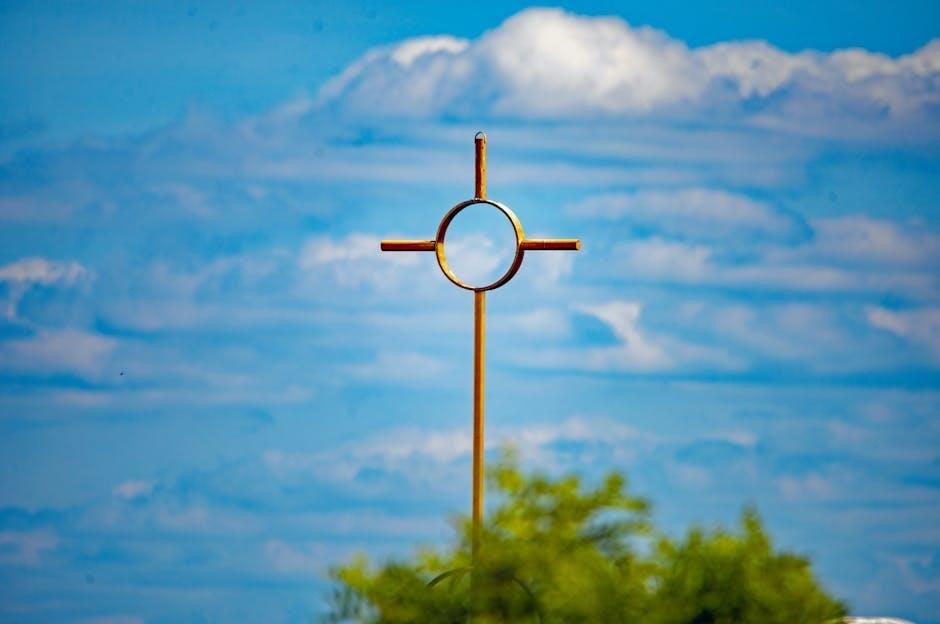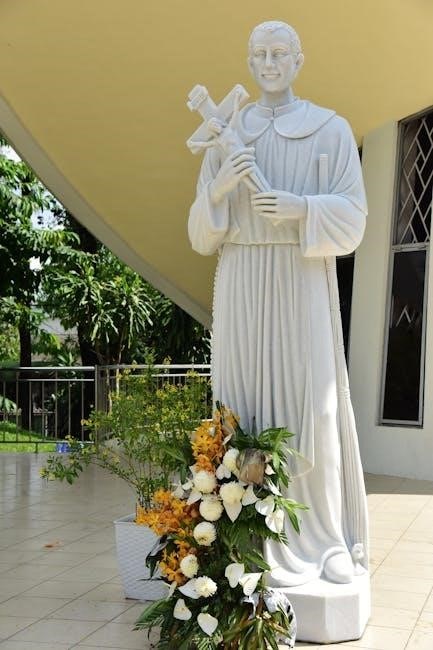The Stations of the Cross, or Via Crucis, is a devotional practice reflecting on Jesus’ journey to crucifixion. It involves 14 stations, each commemorating specific events, fostering spiritual connection and reflection, especially during Good Friday.
What Are the Stations of the Cross?
The Stations of the Cross, also known as the Way of the Cross or Via Crucis, are a series of 14 devotional reflections that trace the events of Jesus Christ’s journey from condemnation to burial. Each station represents a specific moment in the Passion of Christ, as depicted in Scripture and tradition. The practice involves prayer, meditation, and often physical movement between stations, which are typically marked with images or symbols. The stations are not only a historical recounting but also a spiritual invitation to connect with Christ’s sacrifice and resurrection. They are commonly observed during Lent, particularly on Good Friday, and are a powerful tool for deepening faith and fostering compassion. The 14 stations provide a structured way to reflect on the depth of God’s love and the redemptive power of Christ’s suffering.
Historical Significance of the Stations of the Cross
The Stations of the Cross hold profound historical significance as a devotional practice rooted in early Christian pilgrimage. The tradition traces back to the Via Dolorosa in Jerusalem, where believers retraced Jesus’ final journey. Over centuries, this practice evolved, and by the 18th century, the Catholic Church formalized the 14 stations, incorporating both scriptural events and traditional narratives. The Stations of the Cross became a way for the faithful to connect with Christ’s Passion, even for those unable to visit the Holy Land. This practice has endured for centuries, adapting to cultural and liturgical changes while maintaining its core spiritual purpose. The Stations of the Cross remain a vital part of Christian devotion, particularly during Lent, offering a tangible way to reflect on the sacrifice and redemption central to the faith.
The Purpose of the Stations of the Cross in Christian Devotion
The Stations of the Cross serve as a powerful tool for deepening one’s spiritual connection to Christ’s Passion. By meditating on each station, believers reflect on the sacrifices and suffering Jesus endured, fostering empathy and gratitude. This practice encourages followers to contemplate the redemptive love of God and the significance of Christ’s sacrifice for humanity. The Stations of the Cross also provide a structured way to engage in prayerful reflection, especially during Lent and on Good Friday. They help believers to walk spiritually alongside Jesus, rekindling their faith and renewing their commitment to living according to His teachings. The practice is both a personal and communal devotion, offering a meaningful way to honor the Lord’s journey to Calvary and to seek spiritual growth through shared prayer and contemplation.

The 14 Stations of the Cross Explained

The Stations of the Cross are a series of 14 devotional reflections depicting the final events of Jesus’ life, from His condemnation to His burial. They are used for prayer and reflection, especially during Good Friday, as seen in traditions like the one at the Cemetery of the Holy Rood, where participants honor each station with song and prayer.
Station 1: Jesus Is Condemned to Death
Station 1 reflects on Jesus’ condemnation to death by Pontius Pilate, as described in the Gospels. This event marks the beginning of His journey to Calvary. Pilate, despite finding no guilt in Jesus, succumbs to the pressure of the crowd and sentences Him to crucifixion. This station invites believers to contemplate the injustice and sin that led to Jesus’ condemnation, as well as the sacrifice He willingly accepted for humanity’s salvation. It serves as a powerful reminder of the consequences of sin and the depth of God’s love. During Lent, especially on Good Friday, this station is often prayed to reflect on the gravity of Jesus’ sacrifice and the call to repentance. The image of Jesus standing before Pilate, crowned with thorns, is a poignant symbol of His humility and obedience to God’s will.
Station 2: Jesus Takes Up His Cross
Station 2 depicts Jesus taking up His cross after being condemned by Pontius Pilate. This moment symbolizes the beginning of His physical and spiritual journey to Calvary. The cross represents the burden of sin and the sacrifice Jesus willingly accepts for humanity’s redemption. In this station, believers are invited to reflect on their own crosses and how they carry them in life. The act of taking up the cross is a profound expression of obedience, love, and surrender to God’s will. It reminds Christians to embrace their struggles and unite them with Christ’s sacrifice. During Lent, this station encourages prayer for the strength to bear life’s challenges with faith and courage. The image of Jesus carrying the cross is a powerful reminder of His love and the call to follow Him, even in the face of adversity.
Station 3: Jesus Falls for the First Time
Station 3 marks the first fall of Jesus as He carries His cross. This moment symbolizes the weight of sin and the physical toll of His journey. The fall represents human frailty and the struggles believers face in their own lives. It invites reflection on how Jesus’ sacrifice relates to personal hardships. The image of Jesus falling reminds us of His humility and willingness to endure suffering for the redemption of humanity. This station encourages prayer for strength to persevere through life’s challenges and to trust in God’s plan. It also serves as a reminder of the importance of rising again after falling, both literally and spiritually. The first fall of Jesus is a poignant moment in the Passion narrative, emphasizing His vulnerability and divine love. It calls believers to unite their struggles with Christ’s, fostering empathy and gratitude for His sacrifice.

Station 4: Jesus Meets His Mother
Station 4 captures the deeply emotional moment when Jesus encounters His mother, Mary, along the path to Calvary. This poignant meeting underscores the profound sorrow and love shared between them. Mary, witnessing her Son’s suffering, embodies the universal experience of a mother’s pain. Jesus’ glance conveys comfort and strength, reassuring her of the divine plan. This station invites reflection on the bond between parent and child, as well as the trust required to surrender to God’s will. It also highlights Mary’s role as a symbol of faith and perseverance. Devotionally, this station encourages prayers for mothers, families, and those experiencing sorrow, reminding us to turn to Mary for intercession. The encounter serves as a reminder of the power of love and sacrifice, uniting human and divine in a shared moment of vulnerability and grace.
Station 5: Simon of Cyrene Helps Jesus Carry the Cross
Station 5 recounts the moment Simon of Cyrene is compelled to assist Jesus in carrying the cross. This act, compelled by Roman soldiers, symbolizes both the physical and spiritual burdens Christ endured. Simon’s involvement highlights the universal call to share in others’ struggles, reflecting the Christian duty to assist those in need. The scene also underscores the humanity of Jesus, who, weakened by His suffering, accepts help from another. This station invites reflection on the importance of compassion, service, and humility. It reminds believers to embrace their own crosses and support one another in times of hardship. The image of Simon and Jesus together serves as a powerful reminder of the interconnectedness of human experiences and the divine plan unfolding through everyday encounters. This moment also symbolizes the transformative power of unexpected acts of kindness and service.
Station 6: Veronica Wipes the Face of Jesus
Station 6 captures the compassionate act of Veronica, who bravely steps forward to wipe the face of Jesus as He carries the cross. This moment, though not explicitly mentioned in Scripture, has become a cherished part of Christian tradition. Veronica’s gesture symbolizes profound devotion and mercy, offering comfort to Jesus in His suffering. The image of Jesus’ face imprinted on her cloth, known as the Veil of Veronica, is often seen as a miraculous sign of His divine presence. This station invites believers to reflect on the importance of compassion and courage in the face of adversity. Veronica’s actions remind us that even small acts of kindness can have profound spiritual significance. Her bravery also highlights the role of ordinary individuals in the divine plan, encouraging followers to emulate her selfless love and faith. This moment serves as a powerful reminder of the transformative power of mercy and devotion.
Station 7: Jesus Falls for the Second Time
Station 7 marks the second fall of Jesus as He carries the cross to Calvary. This moment underscores the physical and spiritual toll of His journey, emphasizing His human vulnerability. Despite His divine nature, Jesus experiences exhaustion and pain, mirroring the struggles of humanity. The second fall serves as a poignant reminder of the weight of sin and the sacrifices made for redemption. It invites believers to reflect on their own struggles and the times they have faltered in their faith. The image of Jesus falling again encourages prayer for strength and perseverance, especially during life’s challenges. This station also highlights the importance of humility and the willingness to bear burdens, even when overwhelmed. By meditating on this fall, the faithful are reminded of the universal human experience of weakness and the need for divine grace to overcome it.
Station 8: Jesus Speaks to the Women of Jerusalem
At Station 8, Jesus encounters a group of weeping women from Jerusalem who mourn His fate. Despite His own suffering, Jesus consoles them, saying, “Do not weep for me, but weep for yourselves and for your children.” This moment highlights Jesus’ compassion and foresight, as He warns of the sorrows that will come upon Jerusalem. The women’s tears reflect the deep emotional connection many feel with Jesus’ Passion, while His words call believers to reflect on their own lives and the world’s need for redemption. This station invites prayer for those suffering and for the grace to trust in God’s plan, even amidst uncertainty. It also emphasizes the importance of empathy and the call to comfort others, as Jesus did in His darkest hour. This moment reminds us to look beyond our own pain and consider the broader spiritual implications of His sacrifice.
Station 9: Jesus Falls for the Third Time
Station 9 marks Jesus’ third fall while carrying the cross, a moment of extreme physical and spiritual exhaustion. Despite His divine nature, Jesus experiences human frailty, emphasizing His willingness to endure suffering for humanity’s salvation. This fall symbolizes the weight of sin and the struggles believers face in their own lives. It invites reflection on perseverance, trust in God, and the acceptance of life’s challenges. The third fall also underscores the importance of humility and surrender, as Jesus, in His weakness, still moves forward toward His ultimate sacrifice. This station encourages prayer for strength in adversity and gratitude for Jesus’ unwavering commitment to His mission. It serves as a powerful reminder of the transformative power of love and sacrifice, even in the face of overwhelming hardship. Through this fall, Jesus teaches us to embrace our crosses and trust in God’s plan.
Station 10: Jesus Is Stripped of His Garments
At Station 10, Jesus is stripped of His garments, a moment of profound vulnerability and humiliation. This act, carried out by Roman soldiers, symbolizes the complete stripping away of His dignity and humanity. The stripping of His clothes represents the total surrender of His earthly life and the exposure of His divine mission. It also reflects the stripping of humanity’s sins, as Jesus bears the weight of the world’s transgressions. This station invites believers to reflect on the depths of Jesus’ sacrifice and the humility required to embrace His will. The stripping of garments serves as a stark reminder of the brutality of crucifixion and the ultimate act of love Jesus undertook for humanity’s redemption. It encourages prayer for the grace to surrender worldly attachments and to embrace humility in imitation of Christ. This moment underscores the profound sacrifice that paved the way for salvation.
Station 11: Jesus Is Nailed to the Cross
Station 11 depicts the brutal moment when Jesus is nailed to the cross, a pivotal event in His passion. Roman soldiers drive nails into His hands and feet, securing Him to the wooden cross. This act of crucifixion symbolizes the ultimate sacrifice Jesus makes for humanity’s sins. The nailing represents the irreversible commitment to His mission of redemption, emphasizing the physical and emotional suffering He endures. The cross becomes a symbol of both pain and salvation, reminding believers of the depth of God’s love. This station invites reflection on the willingness to endure suffering for the sake of others and the acceptance of God’s will. It also serves as a reminder of the profound sacrifice that underpins Christian faith, urging believers to pray for the strength to carry their own crosses in life. The nailing of Jesus to the cross is a powerful reminder of His unwavering love and devotion to humanity.
Station 12: Jesus Dies on the Cross
Station 12 marks the culmination of Jesus’ passion, as He dies on the cross. This moment is central to Christian theology, symbolizing the ultimate sacrifice for humanity’s sins. As Jesus breathes His last, He utters the words, “It is finished,” signifying the completion of His mission. The cross, once a symbol of suffering, becomes a triumph of love and redemption. The death of Jesus represents the fulfillment of prophecy and the divine plan for salvation. The physical suffering is profound, yet His spirit remains unbroken, demonstrating unwavering obedience to God’s will. This station invites believers to reflect on the depth of God’s love and the price paid for forgiveness. It also serves as a reminder of the hope of eternal life through Christ’s resurrection. The death of Jesus on the cross is a powerful symbol of sacrifice, love, and redemption, resonating deeply in the hearts of the faithful.

Station 13: Jesus Is Taken Down from the Cross
Station 13, “Jesus Is Taken Down from the Cross,” depicts the moment when Jesus’ lifeless body is removed from the cross. This poignant scene, often referred to as the “Deposition,” is a profound expression of love and grief. Joseph of Arimathea and Nicodemus, with the help of others, carefully lower Jesus’ body, wrapping it in linen cloth. The emotional weight of this moment is palpable, as Mary, Jesus’ mother, and other disciples mourn the loss of their beloved Savior. This station invites reflection on the humanity of Christ and the depth of His sacrifice. It also serves as a reminder of the compassion and devotion of those who remained faithful to Him, even in death. The act of taking Jesus down from the cross symbolizes the end of His earthly suffering and prepares for His burial, foreshadowing the hope of resurrection. This moment is a powerful reminder of God’s love and the cost of redemption.
Station 14: Jesus Is Buried in the Tomb

Station 14, “Jesus Is Buried in the Tomb,” marks the final act of love and devotion as Jesus’ body is laid to rest. After being taken down from the cross, His body is wrapped in linen cloth and anointed with spices by Joseph of Arimathea and Nicodemus. A donated tomb, intended for Jesus’ rest, becomes the place where His earthly journey concludes. This station evokes profound emotions, as it signifies the end of His physical presence among His followers. The burial represents the culmination of His sacrifice and the completion of His mission. It also serves as a moment of transition, as the disciples and loved ones mourn while holding onto the hope of resurrection. The tomb, a symbol of rest and waiting, reminds believers of the promise that death is not the end but a passage to eternal life. This station invites reflection on the depth of God’s love and the transformative power of sacrifice.

Practical Uses of the 14 Stations of the Cross PDF
The 14 Stations of the Cross PDF is a versatile tool for personal reflection, community prayer, and educational purposes, offering accessibility on various devices for anytime, anywhere devotion and use.
How to Create a 14 Stations of the Cross PDF

Creating a 14 Stations of the Cross PDF involves compiling images, prayers, and reflections for each station. Start by selecting high-quality images or illustrations that represent each station. Use design software like Canva or Adobe Acrobat to arrange the content neatly. Include the title of each station, a brief description, and relevant prayers or Bible verses. Add a table of contents for easy navigation. Ensure the PDF is mobile-friendly and accessible for personal or group devotion. You can also include hymns or meditational quotes to enhance the spiritual experience. Finally, save and share the PDF for use in churches, schools, or personal reflection. This format allows users to carry the Stations of the Cross conveniently, making it a practical tool for faith-based activities.
Benefits of Using a PDF for the Stations of the Cross

Using a PDF for the Stations of the Cross offers numerous benefits, particularly for devotional purposes. It provides a portable and accessible format, allowing individuals to carry the Stations on their mobile devices for personal or group reflection. PDFs are easily shareable via email or social media, making them ideal for faith communities. They also enable the inclusion of images, prayers, and Bible verses, enhancing the spiritual experience. Additionally, PDFs are consistent across devices, ensuring everyone follows the same format. This digital format reduces the need for physical materials, making it environmentally friendly. Overall, a PDF simplifies and enriches the practice of the Stations of the Cross, catering to both individual and communal devotion.
How to Incorporate the Stations of the Cross into Daily Devotion

Incorporating the Stations of the Cross into daily devotion can deepen one’s spiritual connection and reflection on Christ’s sacrifice. Begin by setting aside a dedicated time, such as during Lent or on Fridays, to pray through the Stations. Use a PDF guide to follow the 14 Stations sequentially, pausing at each to reflect on the accompanying prayers, Scriptures, and meditations. For a more immersive experience, combine the practice with visual aids like images or videos of the Stations. Individuals can also adapt the practice to their schedule by reflecting on one or two Stations daily, gradually completing the entire sequence over time. Group devotionals can be organized, fostering communal prayer and shared spiritual growth. This practice not only honors the Passion of Christ but also invites believers to walk alongside Him, renewing their faith and commitment to His teachings.
Conclusion
The Stations of the Cross, a profound devotional practice, offer a deeply personal and communal way to reflect on Christ’s Passion. By using a 14 Stations of the Cross PDF, individuals and communities can easily access guided prayers, meditations, and visuals, enhancing their spiritual journey. This practice, rooted in tradition, invites believers to walk alongside Jesus, fostering empathy, gratitude, and renewed faith. Whether observed during Lent, on Good Friday, or as a daily devotion, the Stations of the Cross provide a meaningful way to connect with the sacrifice and love of Christ. Embracing this practice, especially through accessible formats like PDFs, ensures its relevance and impact for modern Christians seeking to deepen their relationship with God.
